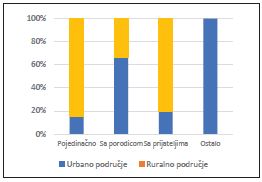Willingness of urban and rural population to join the non-wood forest products supply chain in the area of Drvar
DOI:
https://doi.org/10.7251/GSF1929045MKeywords:
education, non-wood forest products, population, useAbstract
Forests, besides timber, provide many other useful goods and services that have commercial value, and the overall term is non-wood forest products (NWFP), which can be the backbone of rural development (Fuashi et al., 2011). NWFP and services include various fruits of forest trees and shrubs, mushrooms, and especially social forest services such as recreation, tourism, hunting, photo hunting, and the like. (Vuletic, 2009). This paper presents research aimed at establishing the perception of NWFP by urban and rural population and their willingness to be included in the chain of use on the example of the municipality of Drvar. This municipality is taken as a case study, where 60 inhabitants, 30 from urban and 30 from rural area, are selected by random sampling and surveyed. They are asked about their socio-economic status, knowledge about NWFP, attitude toward collection and processing etc, with related legislation being reviewed as well. The results show that, among other things, rural inhabitants deem forests as a source of NWFP more highly than urban one, and that only 6 examinees possess any form of formal education related to NWFP. Most of those who collect do this for personal use rather than for commercial. Most pickers from the rural area spend 8–20 days/year on the collection, and those from the urban area up to 7 days/year. When it comes to volume, most pickers collect over 50 kg/year. Among urban pickers, there is a significant proportion of those who collect up to 10 kg/year. Most examinees from the urban area believe that climate change will be the biggest problem for the collection of NWFP in the future, while rural examinees think that the biggest problem in the future will be the reduction of forest areas. The availability of the aforementioned goods and services and low start-up costs can encourage the emergence of small businesses, which can be an important factor in rural development and poverty reduction.

Downloads
Published
Issue
Section
License
Copyright (c) 2019 Dane Marčeta, Dejan Grahovac

This work is licensed under a Creative Commons Attribution 4.0 International License.

